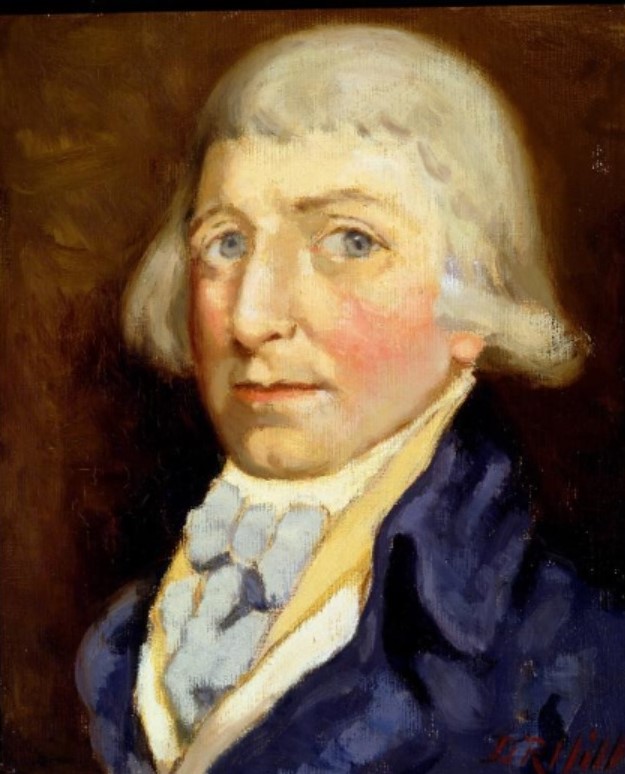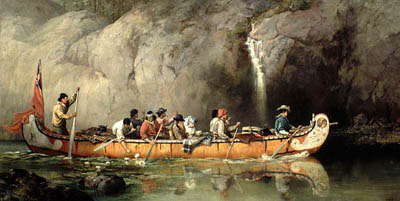Browse "Fur Trade"
-
Article
Albert Johnson, “The Mad Trapper of Rat River”
Albert Johnson, also known as the “Mad Trapper,” outlaw (born circa 1890–1900, place of birth unknown; died 17 February 1932 in Yukon). On 31 December 1931, an RCMP constable investigating a complaint about traplines was shot and seriously wounded by a trapper living west of Fort McPherson, NT. The ensuing manhunt — one of the largest in Canadian history — lasted 48 days and covered 240 km in temperatures averaging -40°C. Before it was over, a second policeman was badly wounded and another killed. The killer, tentatively but never positively identified as Albert Johnson, was so skilled at survival that the police had to employ bush pilot Wilfrid “Wop” May to track him. The Trapper’s extraordinary flight from the police across sub-Arctic terrain in the dead of winter captured the attention of the nation and earned him the title “The Mad Trapper of Rat River.” No motive for Johnson’s crimes has ever been established, and his identity remains a mystery. This article contains sensitive material that may not be suitable for all audiences.
"https://d2ttikhf7xbzbs.cloudfront.net/media/new_article_images/AlbertJohnson/na-1258-114.jpg" // resources/views/front/categories/view.blade.php
https://d2ttikhf7xbzbs.cloudfront.net/media/new_article_images/AlbertJohnson/na-1258-114.jpg
-
Article
Alexander Henry
Alexander Henry, fur trader (born in August 1739 in New Jersey, USA; died 4 April 1824 in Montreal, QC). He was one of the first English traders, known as the "pedlars from Quebec," to do business in the North-West following 1763.
"https://d2ttikhf7xbzbs.cloudfront.net/media/media/a988aa22-bfba-4635-a6d5-8c15fbcd0c0f.jpg" // resources/views/front/categories/view.blade.php
https://d2ttikhf7xbzbs.cloudfront.net/media/media/a988aa22-bfba-4635-a6d5-8c15fbcd0c0f.jpg
-
Article
Alexander Henry (The Younger)
Alexander Henry, "the Younger," fur trader (d at Fort George [Astoria, Ore] 22 May 1814), nephew of Alexander Henry, "the Elder."
"https://development.thecanadianencyclopedia.ca/images/tce_placeholder.jpg?v=e9dca980c9bdb3aa11e832e7ea94f5d9" // resources/views/front/categories/view.blade.php
https://development.thecanadianencyclopedia.ca/images/tce_placeholder.jpg?v=e9dca980c9bdb3aa11e832e7ea94f5d9
-
Article
Alexander Ross
Alexander Ross, fur trader, author (b in Morayshire, Scot 9 May 1783; d at Red River [Man] 23 Oct 1856).
"https://development.thecanadianencyclopedia.ca/images/tce_placeholder.jpg?v=e9dca980c9bdb3aa11e832e7ea94f5d9" // resources/views/front/categories/view.blade.php
https://development.thecanadianencyclopedia.ca/images/tce_placeholder.jpg?v=e9dca980c9bdb3aa11e832e7ea94f5d9
-
Article
Andrew Graham
Andrew Graham, fur trader (b probably near Edinburgh, Scot c 1733; d at Prestonpans, Scot 8 Sept 1815). Graham worked for the Hudson's Bay Company at Churchill, York Factory and Ft Severn (1749-75).
"https://development.thecanadianencyclopedia.ca/images/tce_placeholder.jpg?v=e9dca980c9bdb3aa11e832e7ea94f5d9" // resources/views/front/categories/view.blade.php
https://development.thecanadianencyclopedia.ca/images/tce_placeholder.jpg?v=e9dca980c9bdb3aa11e832e7ea94f5d9
-
Article
Peter Bostonais Pangman
Peter (or Pierre) Bostonais Pangman, Métis leader, bison hunter (born 20 October 1791 in the North Saskatchewan River Valley area, present-day AB; died 4 March 1850 in St. François Xavier, present-day MB). Peter Bostonais Pangman was a skilled hunter who helped provide much-needed bison meat to the Red River Colony. He was actively involved in the Pemmican Wars and events surrounding the Battle of Seven Oaks. As part of the Pembina fur trade, Pangman was a key figure who rallied and inspired the Red River Valley Métis to see and express themselves with an identity separate from surrounding Indigenous peoples. The name Bostonais is variously spelled Bastonnais and Bostonnais.
"https://development.thecanadianencyclopedia.ca/images/tce_placeholder.jpg?v=e9dca980c9bdb3aa11e832e7ea94f5d9" // resources/views/front/categories/view.blade.php
https://development.thecanadianencyclopedia.ca/images/tce_placeholder.jpg?v=e9dca980c9bdb3aa11e832e7ea94f5d9
-
Article
Benjamin Frobisher
Benjamin Frobisher, fur trader (b at Halifax, Eng c 1742; d at Montréal 14 Apr 1787), brother of Joseph and Thomas Frobisher.
"https://d2ttikhf7xbzbs.cloudfront.net/media/media/BenjaminFrobisher.jpg" // resources/views/front/categories/view.blade.php
https://d2ttikhf7xbzbs.cloudfront.net/media/media/BenjaminFrobisher.jpg
-
Article
Black Fur Traders in Canada
The role of Black people within the history of the fur trade is rarely considered. Black people were rarely in a position to write their own stories, so often those stories went untold. This owes to a complex set of factors including racism and limited access to literacy. Black people are also not the focus of many historical documents. However, historians have identified several Black fur traders working in different roles, and even an entire family of Black fur traders who left their mark on history.
"https://d2ttikhf7xbzbs.cloudfront.net/media/home-page-images/por-1261-r1.jpg" // resources/views/front/categories/view.blade.php
https://d2ttikhf7xbzbs.cloudfront.net/media/home-page-images/por-1261-r1.jpg
-
Article
Charles de Saint-Étienne de La Tour
Charles de Saint-Étienne de La Tour, colonizer, trader, governor of Acadia (b at Champagne, France 1593; d at Cap de Sable, Acadia 1663). La Tour possibly reached Acadia as early as 1606, living there permanently from 1610.
"https://development.thecanadianencyclopedia.ca/images/tce_placeholder.jpg?v=e9dca980c9bdb3aa11e832e7ea94f5d9" // resources/views/front/categories/view.blade.php
https://development.thecanadianencyclopedia.ca/images/tce_placeholder.jpg?v=e9dca980c9bdb3aa11e832e7ea94f5d9
-
Article
Charles Oakes Ermatinger
Charles Oakes Ermatinger, fur trader, merchant, militia officer and Justice of the Peace (born 1 February 1776 in Montreal, Quebec; died 4 September 1833 in Montreal). Ermatinger played an important role in the economic and social life of the frontier region of Sault Ste. Marie and what was then known as the Upper Country.
"https://d2ttikhf7xbzbs.cloudfront.net/media/media/6778ff80-ea27-4873-96d7-68e5d7765129.jpg" // resources/views/front/categories/view.blade.php
https://d2ttikhf7xbzbs.cloudfront.net/media/media/6778ff80-ea27-4873-96d7-68e5d7765129.jpg
-
Article
Coureurs des bois
Coureurs des bois were itinerant, unlicenced fur traders from New France. They were known as “wood-runners” to the English on Hudson Bay and “bush-lopers” to the Anglo-Dutch of New York. Unlike voyageurs, who were licensed to transport goods to trading posts, coureurs des bois were considered outlaws of sorts because they did not have permits from colonial authorities. The independent coureurs des bois played an important role in the European exploration of the continent. They were also vital in establishing trading contacts with Indigenous peoples.
"https://d2ttikhf7xbzbs.cloudfront.net/media/media/2a01defb-42f2-4ad3-b7f1-cf7966378002.jpg" // resources/views/front/categories/view.blade.php
https://d2ttikhf7xbzbs.cloudfront.net/media/media/2a01defb-42f2-4ad3-b7f1-cf7966378002.jpg
-
Article
Coureurs de côtes
The coureurs de côtes were itinerant traders in 18th-century French Canada.
"https://development.thecanadianencyclopedia.ca/images/tce_placeholder.jpg?v=e9dca980c9bdb3aa11e832e7ea94f5d9" // resources/views/front/categories/view.blade.php
https://development.thecanadianencyclopedia.ca/images/tce_placeholder.jpg?v=e9dca980c9bdb3aa11e832e7ea94f5d9
-
Article
Cuthbert Grant
Cuthbert Grant, fur trader, Métis leader (born circa 1793 in Fort de la Rivière Tremblante, SK; died 15 July 1854 in White Horse Plains, MB). Grant led the Métis to victory at Seven Oaks in 1816 and founded the Métis community Grantown (later St. François Xavier), Manitoba, in 1824. Today, Cuthbert Grant is hailed as a founder of the Métis nation. (See also Indigenous Peoples in Canada.)
"https://d2ttikhf7xbzbs.cloudfront.net/media/media/9707db63-926b-4e0f-acc4-a97b63a8c695.jpg" // resources/views/front/categories/view.blade.php
https://d2ttikhf7xbzbs.cloudfront.net/media/media/9707db63-926b-4e0f-acc4-a97b63a8c695.jpg
-
Article
Daniel Greysolon Dulhut
Daniel Greysolon Dulhut, coureur de bois, fur trader, explorer (b at St-Germain-Laval, France c 1639; d at Montréal 25 Feb 1710). Dulhut helped extend the French trading empire around the Upper Great Lakes.
"https://development.thecanadianencyclopedia.ca/images/tce_placeholder.jpg?v=e9dca980c9bdb3aa11e832e7ea94f5d9" // resources/views/front/categories/view.blade.php
https://development.thecanadianencyclopedia.ca/images/tce_placeholder.jpg?v=e9dca980c9bdb3aa11e832e7ea94f5d9
-
Article
Donald Alexander Smith, 1st Baron Strathcona and Mount Royal
Donald Alexander Smith, 1st Baron Strathcona and Mount Royal, fur trader, railroad financier, diplomat (born 6 August 1820 in Forres, Scotland; died 21 January 1914 in London, England). Smith was a leading businessman, politician, diplomat and philanthropist of the 19th and early 20th century. He was governor of the Hudson’s Bay Company, president of the Bank of Montreal and high commissioner for Canada in the United Kingdom. Smith also played an important role in the development of the Canadian Pacific Railway, the Royal Victoria Hospital in Montreal and the Royal Victoria College for women at McGill University.
"https://d2ttikhf7xbzbs.cloudfront.net/DonaldAlexanderSmith/DonaldAlexanderSmith.jpg" // resources/views/front/categories/view.blade.php
https://d2ttikhf7xbzbs.cloudfront.net/DonaldAlexanderSmith/DonaldAlexanderSmith.jpg
